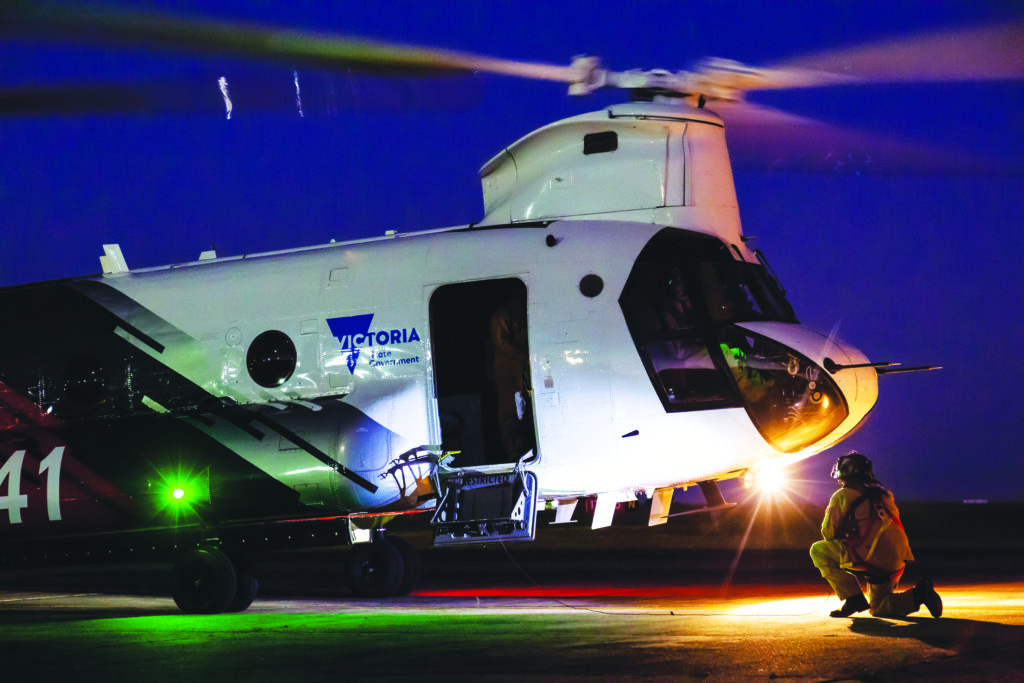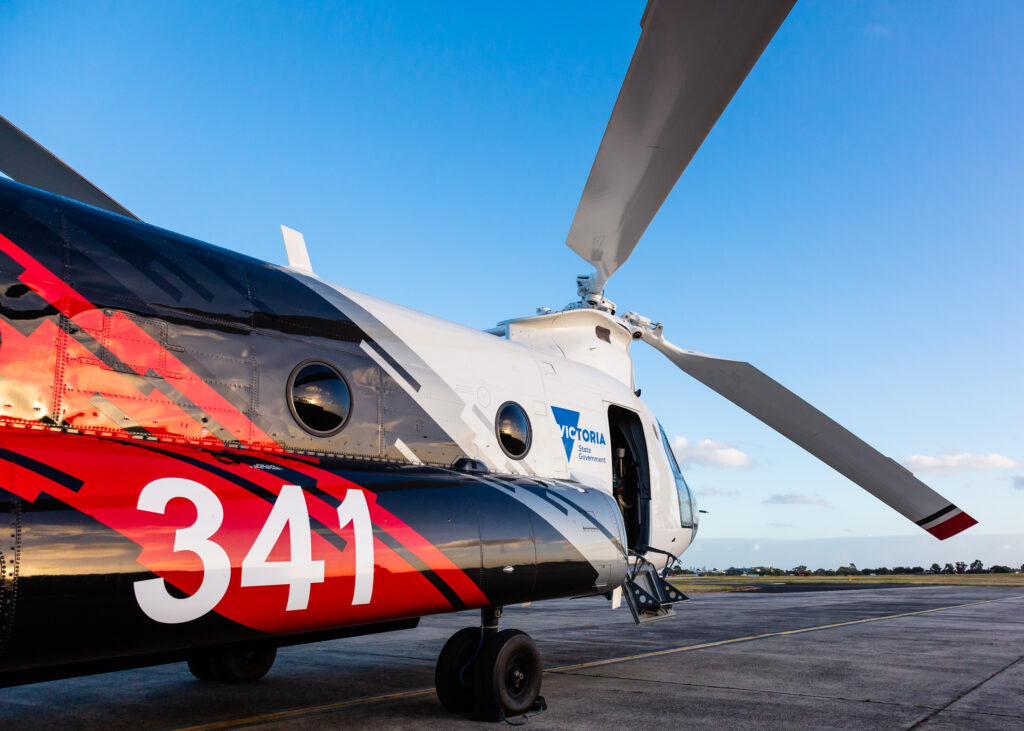Aerial firefighting continues to evolve rapidly worldwide, with a growing demand by various agencies to bring technology and functionality into their contracts. Australia is no different; the country’s National Aerial Firefighting Center (NAFC) is a business unit of the Australasian Fire and Emergency Service Authorities Council (AFAC.) AFAC is in charge of awarding contracts to operators within Australia looking to implement and evaluate these new technologies and have them available for Australian fire agencies.
In Australia, the Victorian Government has been a leader in this field, adopting night aerial firefighting to extend the use of firebombing aircraft.
Following the horrendous 2009 Black Saturday fires in Victoria, which claimed the lives of 173 people, Coulson Aviation took the time to evaluate its operations and undertook a study on how to operate safely and effectively at night using night vision technology consisting of night vision goggles (NVG) and infrared imagery.

In 2011, the company equipped a Sikorsky S-61N and S-76 with night vision goggle technology. These two helicopters were the foundation for the program the company developed in Australia, Northern America, and Canada, proving the system worked using the two helicopters and developing and refining how to deploy the technology.
In 2016, Coulson Aviation began a successful Night Fire Suppression Trial Program in partnership with Emergency Management Victoria (EMV) and the Victorian Government.
Initiated in 2017 was a three-year trial program where Coulson, alongside Kestrel Aviation, worked with Victorian agencies to confirm the processes, procedures, and technology to operate successfully in night fire suppression operations in Victoria. Coulson used an NVG-enabled Type 1 S-61 helitanker and Kestrel’s Type 2 Bell 412 helicopter.
After completing its ‘ trials in Ballarat, the two operators gained approval with Victoria’s support to conduct nighttime firebombing operations for the 2018/2019 summer season.
The Civil Aviation Safety Authority (CASA) approved Coulson Aviation and Kestrel Aviation to undertake night aerial fire suppression operations. Once the approvals were achieved, Coulson Aviation continued to develop a flying operation where the technology was employed, allowing for precision retardant drops during the night.

Coulson was awarded contracts for fire season 2021/2022 with New South Wales and Victorian fire agencies to supply each state with a CU-47D Chinook. In January, Chinook N40CU arrived in Australia and deployed to RAAF Richmond, with N42CU assigned to work in Victoria, deploying from Essendon Fields for its season.
In early 2022, Coulson Aviation received approval from CASA to conduct night fire suppression operations under Night Vision Goggles (NVG) in Australia using the CU-47D very large helitanker.
Before the arrival in Australia, both CH-47s had been successfully operating with the Quick Reaction Force (QRF) in California, where Coulson worked in conjunction with Orange, Ventura, and LA Counties to deploy the QRF with day and night capability.
With Australia’s milder season on the east coast, the NSW and Victorian-based aircraft didn’t see much work on active fires, which became a blessing for local fire agencies. It has also allowed Victorian agencies and crews to conduct familiarization training in regional areas, including fill-up sites and transit routes. The operations were conducted day and night in controlled circumstances.
Emergency Management Commissioner Andrew Crisp said: “It’s so important that we continue to train, for the crew to get to know our state, in the event they might be deployed to a fire.”
“Thanks to residents in Whittlesea, Hume Vale, Kinglake West, Arthurs Creek, Doreen and Strathewen, and the broader Victorian community, who may have seen or heard the Chinook at night.”

N42CU, or Helitak 341 as flown in Victoria, was deployed on a fire north of Melbourne at Conagoderra. Its large tank capacity was used to quickly smother a grass fire that had developed and threatened homes and livestock in the immediate area.
The devastating floods in NSW saw the Chinook N40CU take up a new role. The helicopter’s internal tank was removed so that much-needed supplies could be distributed to the communities affected by this massive natural disaster in the cargo hold of the machine. The helicopter was deployed to several locations in the state, where the flood-affected communities benefitted greatly from its carrying capacity.
Coulson Aviation now has five CU-47D configured for aerial firefighting and is looking to increase this as the demand for the type grows across the globe. Coulson’s CU-47s are deployed each year across North America, Chile, and Australia.
The CU-47s are all fitted with internal tanks with a 10,000-litre capacity (3,000 gallons) Retardant Aerial Delivery System (RADS)-L), modeled on the RADS tank design as fitted to the Coulson C-130 and 737 aircraft. The tank has been scaled down and designed for use in the Chinook.
The tank’s design has some notable features. All tanks fitted to firefighting helicopters have a snorkel to draw water from a water source. Generally, when a snorkel is suspended below, the aircraft limits its airspeed. If the airspeed is too high, the snorkel could damage the helicopter by hitting it while in transit.
Coulson CU-47s generally have a cruise speed of 135 to 140 knots and an endurance of 2.2 hours.
Coulson has designed and fitted a retractable snorkel that retracts into the fuselage to allow higher transit. The snorkel’s stowage enables the CU-47 to maintain normal cruise speeds without restrictions. The stowing of the snorkel also enables the CH-47 to taxi, take off, and land without reliance on the ground crew and prevents damage to the snorkel, which can occur with other tanked helicopters.
In a hover, the snorkel takes just four seconds to deploy and six seconds to retract; the pilots and flight engineers can monitor the system’s operation; by the flight engineer or via a high-definition belly-mounted camera feed displayed on the touchscreen controller.
Two pilots and a flight engineer with ground support provided by a crew of four, all with vast military and civilian experience in operations crew Coulson Chinooks.
The Australian-contracted CU-47s will return to work for the Northern fire season after their contracts in March. They will both return to Australia again for the start of the 2022/2023 season.


